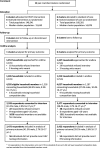Does community-based distribution of HIV self-tests increase uptake of HIV testing? Results of pair-matched cluster randomised trial in Zambia
- PMID: 34275868
- PMCID: PMC8287620
- DOI: 10.1136/bmjgh-2020-004543
Does community-based distribution of HIV self-tests increase uptake of HIV testing? Results of pair-matched cluster randomised trial in Zambia
Abstract
Objectives: Ending HIV by 2030 is a global priority. Achieving this requires alternative HIV testing strategies, such as HIV self-testing (HIVST) to reach all individuals with HIV testing services (HTS). We present the results of a trial evaluating the impact of community-based distribution of HIVST in community and facility settings on the uptake of HTS in rural and urban Zambia.
Design: Pair-matched cluster randomised trial.
Methods: In catchment areas of government health facilities, OraQuick HIVST kits were distributed by community-based distributors (CBDs) over 12 months in 2016-2017. Within matched pairs, clusters were randomised to receive the HIVST intervention or standard of care (SOC). Individuals aged ≥16 years were eligible for HIVST. Within communities, CBDs offered HIVST in high traffic areas, door to door and at healthcare facilities. The primary outcome was self-reported recent testing within the previous 12 months measured using a population-based survey.
Results: In six intervention clusters (population 148 541), 60 CBDs distributed 65 585 HIVST kits. A recent test was reported by 66% (1622/2465) in the intervention arm compared with 60% (1456/2429) in SOC arm (adjusted risk ratio 1.08, 95% CI 0.94 to 1.24; p=0.15). Uptake of the HIVST intervention was low: 24% of respondents in the intervention arm (585/2493) used an HIVST kit in the previous 12 months. No social harms were identified during implementation.
Conclusion: Despite distributing a large number of HIVST kits, we found no evidence that this community-based HIVST distribution intervention increased HTS uptake. Other models of HIVST distribution, including secondary distribution and community-designed distribution models, provide alternative strategies to reach target populations.
Trial registration number: ClinicalTrials.gov Registry (NCT02793804).
Keywords: Cluster randomised trial; HIV; community-based survey; public health; screening.
©World Health Organization 2021. Licensee BMJ.
Conflict of interest statement
Competing interests: The authors have no competing interests. The contents in this article arethose of the authors and do not necessarily reflect the view of the WorldHealth Organization.
Figures
References
-
- UNAIDS . Accelerating towards 90–90–90. Geneva: UNAIDS, 2018.
-
- UNAIDS . Global AIDS update 2019 — communities at the centre. Geneva: UNAIDS, 2019.
-
- ICAP . Zambia population-based HIV impact assessment. Karachi: ICAP, 2016.
-
- World Health Organization . Consolidated guidelines on HIV testing services. Geneva: World Health Organization, 2015. - PubMed
-
- World Health Organization, UNAIDS . Guidance on provider-initiated HIV testing and counselling in health facilities. Geneva: World Health Organization, 2007.
Publication types
MeSH terms
Associated data
Grants and funding
LinkOut - more resources
Full Text Sources
Medical

